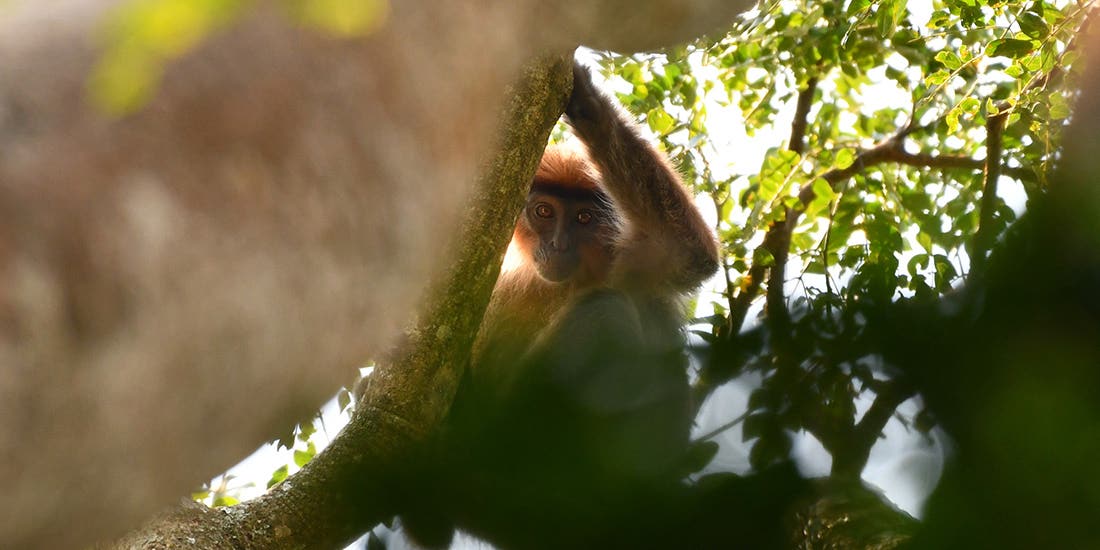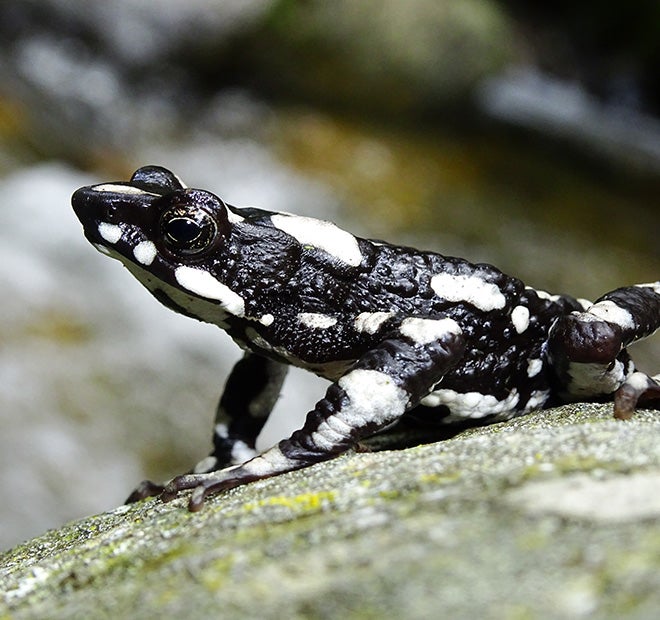While the great apes of Virunga National Park are a central story in the UNESCO World Heritage Site’s history and conservation, the 3,000 square-mile park boasts an array of fascinating animals that don’t always receive their time in the spotlight. Tucked under fallen leaves, blending into branches and shadows, or fishing on the edge of a wetland, the following five creatures are just a few of the thousands of amazing mammals, birds, reptiles, and amphibians that call the Democratic Republic of the Congo (DRC) home.
1) Red Colobus Monkey
With colors and facial expressions as diverse as the landscapes in central Africa that they call home, red colobus monkeys — related to the more familiar black-and-white colobus in Virunga — are only beginning to be studied by conservationists. From Senegal’s coast in the west to the Zanzibar Archipelago in the east, all of the 18 distinct forms of red colobus are categorized as threatened by the IUCN Red List, with status ranging from Vulnerable to Critically Endangered. As a group, they are considered the most threatened monkeys on the African continent. The Kisangani Red Colobus (sighted in 2020 after 40 years of being lost to science) and the Semliki Red Colobus (not seen in Virunga since 1991) are elusive residents of Virunga.
Living in small groups high up in the forest canopy, red colobus are able to digest toxic leaves and unripened fruit with their four-chambered stomachs, making them important seed dispersers for the forest. To strengthen protections and conservation for red colobus, Re:wild maintains the Red Colobus Conservation Network, connecting over 170 red colobus conservationists across the world, who learn from each other in a peer-to-peer exchange to preserve these primates.
2) Rhinoceros Viper
Watch your step! Hiding in the brown leaf litter on the forest floor, preparing to ambush its next meal, may be one of the most distinctive snakes of western and central Africa. The Rhinoceros Viper, or “river jack,” is a short, heavy-bodied snake known for the horn-like protrusions on the tip of its nose. Its rough scales — sharp enough to cut your hands —compose a mesmerizing design of blue and green oblong shapes with accented yellow lines. Full of surprises, this viper is venomous but not aggressive, generally slow-moving but quick when striking its prey, namely rodents and amphibians. An occasional tree-climber and swimmer of shallow pools, this snake is impressively versatile! The species has declined in numbers due to habitat loss and over-harvesting for food and for the international pet trade. This species is currently listed as Vulnerable on the IUCN Red List.
3) Shoebill
Look into the large, golden eyes of a Shoebill and you might feel transported to prehistoric time. Standing up to five feet tall with an eight-foot wingspan, this is one beast of a bird. The Shoebill’s wide beak — shaped like a dutch clog — is perfect for catching lungfish, its preferred food in the freshwater swamps it calls home. This bird stands for hours waiting for its catch, lunging towards the water at the precise moment in a hunting behavior called “collapsing.” Not easily classified, the Shoebill has been grouped with herons, storks and pelicans and also has its own order, Balaenicipitiformes. With a declining population of 3,300 to 5,300, the IUCN Red List classifies this bird as Vulnerable due to wetland destruction across its range from South Sudan to Zambia.
4) Rwenzori Three-horned Chameleon
In the mountainous terrain of the Albertine Rift in central Africa, hiding in plain sight is a lizard from a fairytale. The three horns on the head of the male Rwenzori Three-horned Chameleon — one on the nose and two on the ridge between its eyes — would put any unicorn to shame. But they’re not just for looks. The horns come in handy in fights over mates and territory. With panoramic vision, this chameleon can focus on prey or predators without moving its head, preparing for a quick tongue shot at an unsuspecting insect or to slink away unnoticed. Only found 6,000 feet above sea level in the Rwenzori mountains, this striking lizard is spotted on branches or tree trunks. The males put on a show for nearby females by changing their special skin cells from dull browns to dazzling bright blues, greens and yellows. Definitely a hard-to-ignore species, that is if you can find them.
5) Okapi
The Okapi is an iconic species of the DRC, featured on its banknote and revered by Congolese peoples like the Mbutu Indigenous peoples. Towering above other animals, Okapi are known as “forest giraffes” — males have horn-like bumps on their heads, like their much taller giraffe cousins. Most distinctive are the white-and-black stripes on Okapis’ legs, which camouflage its outline as it forages for fruit, buds and leaves from over 100 plant species in the tropical forests of north-eastern DRC. Its oily hair acts as a water barrier and its 18-inch-long tongue easily cleans its entire body — eyes and ears included. Introduced to foreign scientists near the turn of the 20th century, Okapis remained elusive within Virunga National Park for over half a century, before they were first photographed with a remote camera in 2008 in the Semliki Valley. Okapis are listed as Endangered by the IUCN Red List due to their declining numbers, which are impacted by habitat destruction, and hunting for their meat and skin. It’s estimated that 25,000 Okapi remain in the DRC.
Virunga National Park is one of the most special places on the planet. It is Africa’s oldest and most biologically diverse protected area. Visit, https://www.rewild.org/wild-about/virunga-national-park to help support our work in protecting Virunga National Park. One hundred percent of your donations will go toward Virunga’s rangers and the necessary operational costs to ensure they are well supported.
Katie Doke Sawatzky is a journalist originating from and living on the dwindling Canadian Prairie, in Treaty 4 territory and the homeland of the Métis. Her multimedia project prairiecommons.ca examined the state of native prairie in Saskatchewan, its biodiversity, and its public and spiritual value. She is based in Regina.




